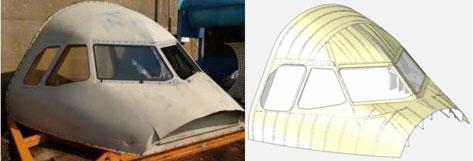

A 10-metre long gas gun shooting drone components into an airliner windscreen. Sounds scary? It is less scary than a real mid-air collision between a drone and a plane or a helicopter. With the prospects of this happening in the future, researchers have geared up to find out exactly how dangerous a collision between a drone and a passenger jet or helicopter could be. The results of this state-of-the art laboratory collision testing and modelling show that even a small drone could do substantial damage.
The UK Department for Transport, the Military Aviation Authority and the British Pilots’ Association BALPA, published the results of those tests in July, covering both helicopters and fixed-wing aircraft. The findings – summarised in this report – reveal that consumer drones could “critically damage” helicopter windshields and tail rotors. Particularly vulnerable are non-bird strike certified helicopter windscreens, typically used for general aviation aircraft. Such windscreens prove to have a low resistance to all the classes of drones tested.
The test showed that even the smallest drone (0.4 kg) would penetrate through the non-bird strike certified windscreen at speeds well below the normal helicopter cruising speed. For a fixed-wing drone (3.5 kilogram), it was found that the drone could penetrate a helicopter windscreen of this type even if the helicopter was stationary.
The bird strike certified helicopter windscreen, generally more resistant, was not spared. Heavier drones could still penetrate these windscreens at helicopter’s typical cruising speed. And by using different computer simulations and modelling, researchers found that helicopter tail rotors would be vulnerable to impacts with all types of drones. Due to the very high speed of a rotating tail rotor blade, it could be critically damaged by an impact with any drone.
Even windscreens of airliners, which have a more resistant construction than those of helicopters, are vulnerable to damage. It was found that the airliner windscreens, although substantially damaged, could retain integrity if hit by a drone up to speeds typically flown at during the aircraft landing and later stages of the approach.

The tests showed that the drone construction plays a critical part in the severity of a collision. Exposed metallic components of drones can cause significant damage to aircraft windscreens. This is a particularly important aspect for drone manufacturers, who would be able to adapt the materials and designs of drones, provided regulatory standards exist.
While many studies have already tested the impact of bird strikes on aircraft, some drone components – such as the motors and batteries – are much harder and potentially more damaging than ‘fluid’ birds. While comparisons to bird strikes are useful, components of drones do not behave in the same way as an equivalent of mass bird under similar conditions. In fact, even lighter drones could cause more damage than a bird.
This study affirms aviation experts’ presumption that a drone strike is not like a bird strike: it can be much more severe in consequences. And it shows that further testing is necessary: More scenarios need to be examined, testing different aircraft components, including aircraft engines, and different models of drones. This would help us get a better understanding of the hazards and advance with the solutions. And, it would help the European regulator – who is busy drafting risk-based, operation centric legislation for drone integration in Europe – to actually know the risk that future EU safety rules must be able to mitigate.